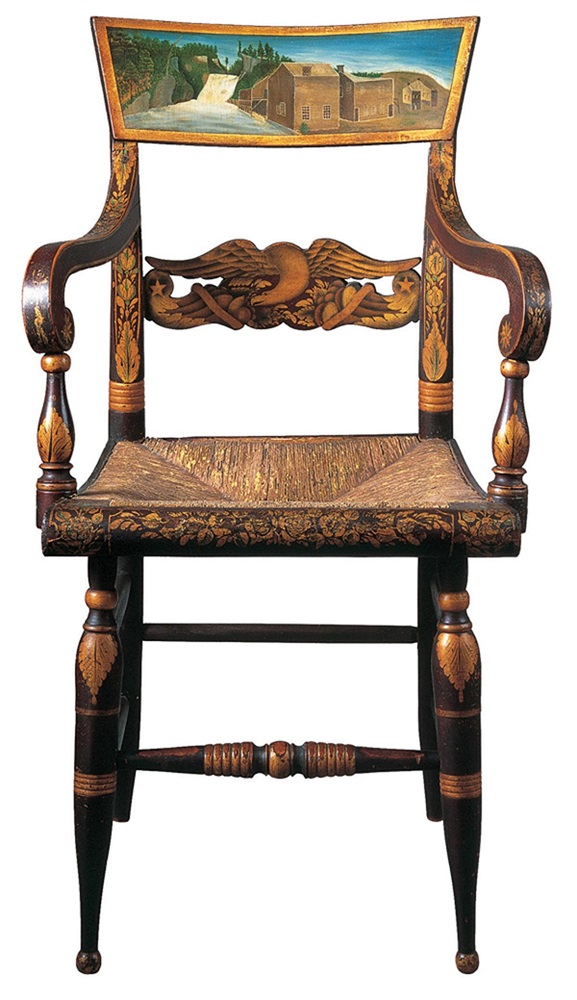
Armchair with View of Ithaca Falls
Chairmaker unidentified; decoration probably by R.H. Ranney (dates unknown), Ithaca, New York
ca. 1817-1825
Paint, bronze-powder stenciling, and gold leaf on wood, with rush seat.
Collection American Folk Art Museum, New York
Gift of Ralph Esmerian, 2005
Armchair with View of Ithaca Falls
Chairmaker unidentified; decoration probably by R.H. Ranney (dates unknown), Ithaca, New York
ca. 1817-1825
Paint, bronze-powder stenciling, and gold leaf on wood, with rush seat.
Collection American Folk Art Museum, New York
Gift of Ralph Esmerian, 2005
One of the most interesting, and challenging, parts of my job as an Interpretation Manager at Crystal Bridges involves developing engaging interactive activities for our visitors. For American Made, I had the good fortune of working with Stacy Hollander, the Chief Curator for the American Folk Art Museum, in creating the audio tour experience for the exhibition. Stacy visited Crystal Bridges in the late spring to record some sessions with me, offering fascinating insights into many objects in the show. Time and space constraints for the final product required us to cut out a lot of the great information Stacy shared during those sessions, so I decided to offer excerpts from the audio transcripts here on the Crystal Bridges blog for all to read. Enjoy!
Stace Treat
ITHACA FALLS CHAIR AND FANCY
By Stacy Hollander (as told to Stace Treat during audio tour recording sessions)
The most pervasive philosophy of the eighteenth century was Enlightenment. It was rational, scientific, and idealistic. In its wake there came to be a kind of complimentary philosophy [in folk art] that was called “Fancy.” It was in part a response to archeological discoveries at the ancient Roman city of Pompeii in 1748 that infused the decorative arts with a new vocabulary built on classical motifs that were incorporated into furniture, wallpaper, and plaster work. Fancy was the imaginative part of this new infusion and also a compliment to the Enlightenment, so whereas Enlightenment was driven by science, clarity, and light, Fancy was driven by the ephemeral, the imaginative, the creative. Enlightenment was enduring and persistent, Fancy disappeared in a flash, it was about titillating the senses through the eyes, through light, through color, pattern, and movement.
Fancy became a big idea in and of itself and it came to encompass all kinds of forms—literature, portraiture, furniture decoration, interior decoration—that brought this idea of color and pattern into the wide worlds of painting and patterning, seaweed painting, vinegar patterning, simulations of all kinds of exotic woods on painted furniture, but it also had a more classical aspect to it.

Ithaca Falls, New York
The armchair painted with Ithaca Falls that appears in this exhibition is responding to this more classical aspect of Fancy furniture. Painted landscapes were being done on furniture by Fancy furniture concerns such as the famous Finley Bros. in Baltimore in the early nineteenth century, and they offered two different kinds of landscapes painted on furniture—real landscapes and imaginary landscapes. A person could commission a set of furniture or an individual piece of furniture with a view of his own properties. Much of this art is about conveying to the world what you have attained in your own life. So to depict your properties on your furniture, or in a painting, showed that you had reached a certain level of aspiration. Other landscapes were imaginary, derived from mezzo-tinted engravings or mythological scenes.
This armchair of Ithaca Falls is a real view. It shows that the dissemination of Fancy in furniture had really spread throughout the country by the time this chair was made, probably between 1817 and 1825. The Finleys had advertised as early as around 1807 that they could produce such views. Other artists who had trained in their shop would have moved to other areas of the country and diffused the skills that they had learned in the Finleys’ shop and others like it. They would disseminate this style into rural areas.

Armchair with View of Ithaca Falls (detail)
Chairmaker unidentified; decoration probably by R.H. Ranney (dates unknown), Ithaca, New York
ca. 1817-1825
Paint, bronze-powder stenciling, and gold leaf on wood, with rush seat.
Collection American Folk Art Museum, New York
Gift of Ralph Esmerian, 2005
This chair has a name on the back: R. S. Ranney. We have not identified Ranney, so we don’t know whether he was the recipient of the chair, the decorator of the chair, of the landscape and other decorative elements, or the manufacturer of the chair. The manufacturer and the decorative painter might have been two entirely separate concerns, they may have been a painter who worked within a small manufacturing company, or someone who contracted to do this kind of work, there were many different business arrangements. We do know that it depicts Ithaca Falls because it very closely matches depictions of the falls that were engraved at around this time. And we’re able to pinpoint it in time through a few of the features of this landscape. First, that there are mills and other businesses along the Falls that started arising in this area because of the water power around 1817, so that kind of sets our early date for the chair. If you look very, very closely at the scene, you can also see a flume through which water is coming, so we know that the chair could not have been painted after a certain date because the flume was replaced with a different system, so by looking at the evidence presented in this scene, we are able to glean a lot of information about when the chair was made. The fact that it has a classical-inspired form, which was related to chairs found in Roman and Greek archaeological excavations in the eighteenth and nineteenth centuries, and the different motifs, including our eagle, tells us it’s from our early national period.



